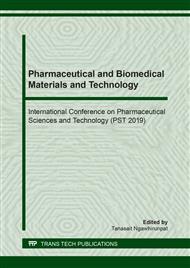p.3
p.9
p.15
p.21
p.27
p.33
p.38
p.45
p.51
Electrostatic Effects of Metronidazole Loaded in Chitosan-Pectin Polyelectrolyte Complexes
Abstract:
Electrostatic interactions of polymeric charges become one of the important factors to form the polyelectrolyte complexes (PECs). In this work, PECs has successfully created through the interaction between positive charges of chitosan (CS) and negative charges of pectin (PE) based on the effect of pH and pKa of the polymers. The formation of PECs provides small particle size, positive surface charge, and high %entrapment efficiency (%EE) after loaded metronidazole (MTZ). Dropwise addition of PE solution into CS solution was carried out to form PECs. A certain concentration of chitosan and pectin fixed at ratio 3:1 while the pH of both polymers varied as pH 1, 3, 5, and 9. The alterations after forming PECs observed particle size, zeta potential, and turbidity of the solution along with FTIR, DSC, and TAG. Precipitation of PECs solution was found in the fixed pH 5 of PE solution dropwise into pH 7 and 9 CS solution, which referred to the unstable of the PECs system. The pH 1 and 9 of PE and CS obtained the large size which about 600-1200 nm, while zeta potential found a low positive charge of 5.54-11.90 mV. Thus, only the fixed pH 5 of CS solution and pH 3, 5, or 7 of PE solution to form PECs were used to load MTZ. After loaded MTZ, the particle size of the PECs was about 400-500 nm and the zeta potential was about 20-50 mV. Electrostatic interactions resulted from FTIR detected the changes in amino groups of CS and carboxyl groups of PE. Thermal analysis on DSC for determinations of melting points or transition temperatures and TGA to monitor weight loss by heat were confirmed the PECs and MTZ-PECs formation. The pH 5 of PE interacts with pH 5 of CS offered the smallest particle size as 438 nm, zeta potential about 23.5 mV, and the highest percentage of EE as about 50% of the drug-loaded. The pH 5 of PE and CS were the pH-responsive to the pKa, thus, the acidity of the polymers may provide a suitable condition to form the appropriate polyelectrolyte complexes. Keywords: Polyelectrolyte complex, polycation, polyanion, charge density
Info:
Periodical:
Pages:
27-32
Citation:
Online since:
August 2019
Authors:
Price:
Сopyright:
© 2019 Trans Tech Publications Ltd. All Rights Reserved
Share:
Citation:


